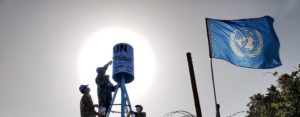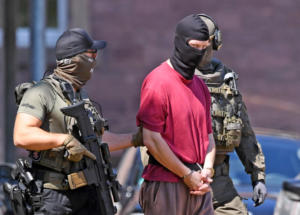By Masako Toki | August 22, 2023
For too long, nuclear weapons narratives have been dominated by those who saw the mushroom cloud from afar or above. Or maybe just in photos, TV, or videos. Most absurdly, the voices of people who suffered the most under the mushroom cloud have often been marginalized.
There have been numerous efforts to raise awareness of the inhumane nature of nuclear weapons among hibakusha (atomic bomb survivors), people in Hiroshima and Nagasaki, and more broadly, in the international community. One of the most important milestones came when the 2010 Nuclear Nonproliferation Treaty (NPT) Review Conference adopted a final document that included, for the first time “the catastrophic humanitarian consequences of any use of nuclear weapons.” Since then, the humanitarian initiative for nuclear disarmament has been gaining momentum.
Three conferences on the humanitarian impact of nuclear weapons contributed to the start of the negotiation of the Treaty on the Prohibition of Nuclear Weapons (TPNW) and to adoption of the treaty. Through this process, a wide range of civil society members, along with like-minded governments, energized the humanitarian initiatives and tenaciously supported bringing humanitarian dimensions to nuclear weapons policy discussion.
The adoption of the TPNW has brought a glimmer of hope to nuclear disarmament advocates, although they are fully aware that this is a first step of the long process. Still, this is considered to be one of very few positive developments in recent nuclear disarmament efforts. The world is currently moving backward on nuclear disarmament. The Russian invasion of Ukraine has caused unspeakable human suffering and raised the risk of nuclear war. Today, nuclear threats are at the highest level since the end of the Cold War,
Hibakusha, atomic bombing survivors, have been tirelessly exerting themselves toward a world free of nuclear weapons, with their only wish that no one else should go through the sufferings they have experienced.
As the memories of Hiroshima and Nagasaki are further fading away every year given the advanced age of hibakusha, it is urgent for younger generations to learn more. Time is of the essence. Earlier this year, the average age of hibakusha reached 85.01 years, according to Japan’s Ministry of Health, Labor and Welfare. In addition, the number of hibakusha decreased by 5,286 to 113,649 this year. As the A-bomb survivors continue to age, the issue of how to pass on the message of the catastrophic impact of nuclear weapons to the next generation becomes increasingly pressing. Informing and educating the next generation is how we can ensure that nuclear weapons will never be used again, and eventually, achieve a world free of nuclear weapons.
The time to learn from hibakusha directly is limited and is getting shorter and shorter. The peace declaration this year read by Nagasaki Mayor Shiro Suzuki quoted Sumiteru Taniguchi, one of the late hibakushas who dedicated his life to nuclear disarmament. Taniguchi admonished that “[p]eople appear to be gradually forgetting the suffering of the past. This forgetfulness terrifies me. I fear that forgetfulness will lead to the acceptance of further atomic bombings.”
This is something we must never allow to happen.
Keiko Ogura, a Hiroshima hibakusha and an English-Japanese interpreter for peace activities, shared her testimonials with world leaders in May this year at the G7 Hiroshima Summit. She asked the leaders to “relive the struggles in the hearts of hibakusha” that have been felt for so long, and to imagine the invisible wounds, traumas, sorrows, and unspeakable secrets through her eyes and heart. One of the most important abilities you need when you work for nuclear disarmament is to be able to empathize with other’s suffering. Ogura asked the G7 leaders to do precisely this. She also sent a message to Russian President Vladimir Putin through a reporter for one of her numerous interviews, saying, “You don’t know what a nuclear weapon is, the reality of a nuclear weapon. So come here and see.”
Earlier this summer, at a civil society event, Ogura calmly started her atomic bombing testimonial by encouraging the audience to imagine how it feels like to be under the mushroom cloud at the time of the bomb’s detonation. “I was at that time under the mushroom cloud you can see there,” while showing the picture of the mushroom cloud after the bomb was dropped.
Nothing is more powerful and effective than hibakusha testimonials in helping others to understand the horrific reality of the use of nuclear weapons. It is very important to imagine what really happened under the mushroom cloud. When you hear about the Hiroshima bombing or the Nagasaki bombing, the first image that comes to your mind may be the mushroom cloud. But we need to understand that people were under the mushroom cloud. Most of the victims were civilians, including small children.
Every year, the Hiroshima and Nagasaki remembrance days come. These are the days that we have to make efforts to remember and renew our resolve to work for nuclear disarmament. Soon, we will not be able to listen to hibakusha directly. As the hibakusha are aging in the middle of increasing nuclear risks, we cannot do business as usual every year, or think about nuclear disarmament only on these remembrance days.
We have to make sure that younger generations understand the horrors of nuclear weapons use. This is why it is important to promote disarmament and nonproliferation education for younger generations, including undergraduatesand high school students. We have to plant seeds, nurture those students, and get them to reach the next step. However, opportunities for high school students and undergraduate students to study disarmament and nonproliferation are scarce. Despite being an existential threat to humanity, nuclear weapons issues are rarely discussed in general conversations, especially among the young.
Certainly, the Oppenheimer film has been exceptionally successful in generating nuclear weapons-related conversations among the public, including young generations. But my concern about the film is how those young people who may have never heard about Hiroshima and Nagasaki, let alone the actual catastrophic consequences of the use of nuclear weapons, would interpret the impact of use of nuclear weapons.
Showing the horror of Hiroshima and Nagasaki was not the main purpose of the movie. But the omission of scenes from those two bombed cities could contribute to sanitization of the real horrors of the use of nuclear weapons. Having heard the testimonials of survivors, the horrors and sufferings they have gone through, I just could not accept the way the movie omitted the suffering of people in Hiroshima and Nagasaki.
At the same time, this movie further motivated me to enhance my efforts to promote disarmament and nonproliferation education for young people, so they have better ideas on the catastrophic humanitarian consequences of nuclear weapons use.
We all should understand that the biggest obstacles to a world without nuclear weapons is a mindset that nuclear weapons are essential for peacekeeping, as Hiroshima Gov. Hidehiko Yuzaki stated in his peace message at this year’s Hiroshima Peace Memorial Ceremony. It is not sustainable to continue relying on nuclear deterrence, which will surely fail at some point. And once it fails, the consequence would lead to the annihilation of humanity. No one, and no leader of any nation can take responsibility for such a consequence. “Should a nuclear war break out, would you simply shrug and say that you never expected it would happen?” as the governor asked.
We need a new way of thinking, wisdom, and action to create a more peaceful world, one in which we do not need to rely on nuclear deterrence to keep the peace. It is therefore essential to engage youth with creative and innovative ideas to address such challenges. We have to create more opportunities for young people to learn about nuclear disarmament issues and most important, to learn about the humanitarian consequences of nuclear weapons use.
The hibakusha will continue to do everything we can to promote disarmament and nonproliferation education to empower and engage young generations. I am so blessed to be able to work with both high school students, and undergraduates toward that goal. These youth are the last generation to be able to directly learn from hibakusha.
One of hibakusha, Masako Wada, with whom I have had the honor to collaborate several times for our center’s education projects, shared her strong resolve in a speech earlier this summer: “Hibakusha will take whatever time remains for each of us to continue to talk with all of you and act to abolish nuclear weapons. We, hibakusha, will never stop fighting to achieve this goal. For that purpose, we want to further collaborate with youth who will shoulder the future of humanity.”
My sincere hope is to be able to work with hibakusha for disarmament education for American students especially, and for many more years to come. Realizing that there is no such thing as “many more years” sobers and pains me. But I feel strong sense of mission, in part because I live in two different cultures, the United States and Japan, while being able to work for young people from both countries for nuclear disarmament. My vow to work toward a world free of nuclear weapons through youth education remains strong and further strengthens me.




